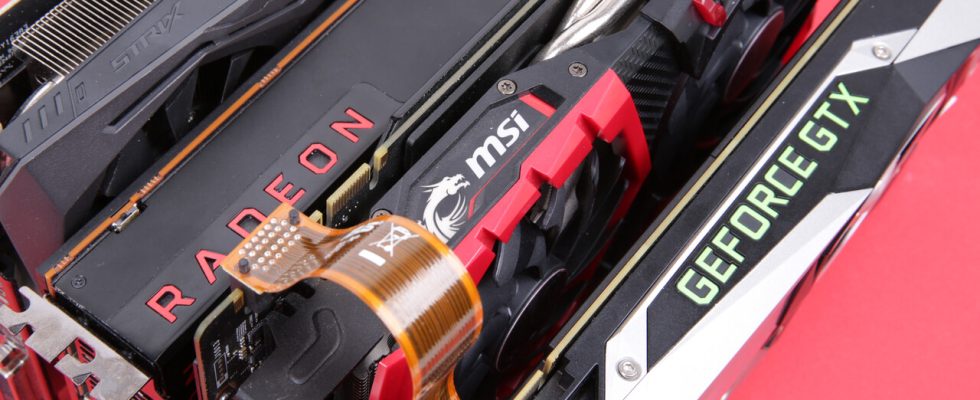Usually fast in the past, now mostly bad: Gaming systems with more than one graphics card used to be not uncommon in the high-end sector thanks to AMD CrossFire and Nvidia SLI, but they haven’t been an issue for years. But have you tried this before? And if so, with which graphics cards and how was the experience?
The dream of double FPS with double graphics cards
How nice would it be if gamers could easily double the FPS in games by using twice the amount of graphics cards? Well, it never worked exactly that way, but with SLI and CrossFire, Nvidia and AMD were there – more precisely, back then ATi – this same promise almost twenty years ago. The (new) beginning was made by Nvidia in the summer of 2004 3dfx‘ old brand name SLI was pulled out of the junk box. The acronym no longer stood for Scan line interleaverather Scalable link interface – which ultimately became problematic – but the goal and purpose were identical: two graphics cards connected to each other in one PC should, at best, deliver twice the gaming performance. Competitor ATi followed suit almost a year later with CrossFire.
Alternate frame rendering for high-end performance
In concrete terms, this worked in most cases because the two built-in GPUs took turns rendering new frames, the key word is Alternate frame rendering. This is why the graphics memory did not double when using two graphics cards, but ultimately remained at the capacity of one model. Basically, for example, two 30 FPS streams became one 60 FPS stream. And that’s where the problem lies: the different frame times of different frame streams, which were also rendered on different graphics cards, led to the infamous micro-stutters.
Nevertheless, SLI and CrossFire enjoyed great popularity for a long time. And not only configurations with two graphics cards were possible, but later even those with three or four GPUs. For years, anyone who wanted the highest performance in terms of FPS had to rely on Nvidia’s SLI or AMD’s CrossFire technology; The frame rate could often be increased by 70 percent or more compared to using a single GPU.
A slow death until 2022
Over the course of the 2010s, the two features were gradually replaced: fewer and fewer games and graphics cards support SLI and CrossFire, the micro-stutter problem became more and more obvious and the issue was never a cheap endeavor anyway. And this is what ComputerBase headlined in the summer of 2018: Usually fast in the past, now mostly bad.
With the Turing generation released a few months later, Nvidia only gave the GeForce RTX 2080 and RTX 2080 Ti (test) as well as the later Titan RTX (test) and then the GeForce RTX 2070 Super (test) an SLI or NVLink option. Connection with. A generation later it was initially only the GeForce RTX 3090 (test) with Ampere. Nvidia’s last gaming graphics card with SLI support was the GeForce RTX 3090 Ti (test) at the beginning of 2022 – the feature has been dead since then. And CrossFire? AMD hasn’t supported this since the Radeon RX 5000.
But how vibrant were multi-GPU technologies within the ComputerBase community? The first question this week is: Have you ever owned a gaming system with more than two GPUs?
And if so, what was your maximum number of graphics cards installed?
The third question is open-ended because it concerns your CrossFire and SLI systems, if you have ever owned such a computer. However, a list of all possible configurations would be far too long to provide the answer options for a classic survey. In this respect, reference should be made to the comments at this point: Have you ever had a multi-GPU system that gave you particular joy?
Which CrossFire or SLI system were you particularly proud of back then?
You are welcome to share pictures of the corresponding computer and the SLI or CrossFire network in the forum, if you have them.
Expensive fun or a missed opportunity?
No question: having to buy not just one graphics card in order to be at the forefront, but two or even more was a costly affair. But graphics cards have consistently become more expensive since then; especially in the high-end segment: Anyone who wants to buy a top model today could have had a system with four GPUs at that price. What was your most expensive graphics card configuration? You are welcome to report in detail in the comments.
And finally: What is your opinion on the subject of CrossFire and SLI – after a few years?
Participation is expressly desired
As always, the editorial team is happy to receive well-founded and detailed reasons for your decisions in the comments on the current Sunday question. If you personally have completely different views that are not covered by the answer options given in the surveys in the article, you can also report them in the forum. Ideas and suggestions for adding content to current or future surveys are also welcome.
Readers who have not yet taken part in the previous Sunday questions are welcome to do so, as the surveys always run for a period of 30 days. The only requirement to participate is a free ComputerBase account. There are often still exciting discussions going on in the forum, especially regarding the last Sunday questions.
The last ten Sunday questions at a glance
Motivation and data use
The data collected as part of the Sunday Questions serves the sole purpose of making the mood within the community and the hardware and software preferences of readers and their development more visible. There is no financial or advertising background and there is no evaluation for market research purposes or the data being transmitted to third parties.

